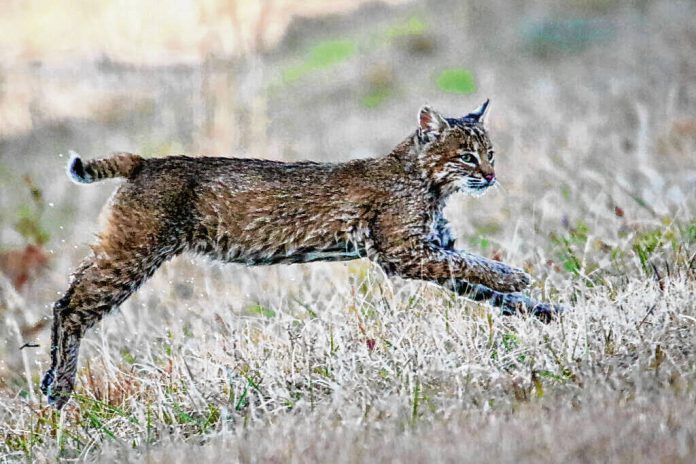For years, efforts to allow hunting and trapping of bobcats in Indiana have proved unsuccessful.
But a bill moving through the General Assembly could soon require the state’s Department of Natural Resources to establish a hunting season for bobcats not later than July 1, 2025.
Sen. Scott Baldwin, R-Noblesville, who authored Senate Bill 241, said populations of bobcats — Indiana’s only native wild cat — have “significantly increased” in the southern and southwestern areas of the state.
The senator, who owns 150 acres in southern Indiana and is a self-described outdoorsman, said he wants to prevent the bobcat population from growing out of hand and threatening other animals, like wild Cottontail rabbits, as well as dogs, cats and other pets.
“I think they’re a majestic creature that I want to see continue in Indiana, but they are 100% an apex predator,” said Baldwin, noting that bobcats will prey on deer, turkeys, cottontails and other small game. “In the interest of maintaining biological and ecological homeostasis, I think it’s important that we determine how we do this responsibly, and who better than our scientists and biologists at the DNR?”
The state agency contemplated a hunting and trapping season for bobcats in 2018 but withdrew the proposed rule after it drew widespread public opposition.
A similar bill was filed in 2019 to open hunting for bobcats but never got a hearing. Baldwin’s bill has so far found more success, advancing 7-1 from the Senate Natural Resources Committee to full chamber.
Farmers, rural Hoosiers call out bobcat ‘problem’
Once an endangered species in Indiana, bobcats were removed from the state’s endangered species list in 2018.
Since then, the bobcat population has grown — especially in recent years, according to the DNR. The animals are most common in southern Indiana, although their numbers north of I-70 are growing, too.
Under Baldwin’s proposal, it would be up to the DNR to determine rules, season dates, what counties would be open, how many bobcats a hunter could take, and the method of killing bobcats.
But even if DNR officials approve bobcat hunting, Baldwin said he doesn’t foresee the DNR would open the season in every county: “I’m just not sure that’s necessary yet.”
Emily Black, Indiana DNR’s legislative and public policy director, said the agency is currently neutral on the bill. The DNR has not made any efforts — legislatively or through rulemaking — to revisit a proposed bobcat season since the last effort failed in 2018.
Most surrounding Indiana — including Iowa, Illinois, Kentucky, Michigan, Missouri, Wisconsin and Pennsylvania — already have hunting seasons for bobcats.
A 2022 Purdue University survey of Hoosier hunters and trappers indicated some support for a bobcat hunting season, but less were in favor of a trapping season.
Still, Charlie Masheck with Hoosier Trapper Supply said “there’s not a day that goes by that I’m not hearing about some sort of encounter with a bobcat.”
“Whether they’re seeing it from a trail cam, from a tree stand, releasing it from their trap, I mean it’s just continuous,” he continued. “We probably needed this season six or seven years ago.”
Owen County farmer Jonathan McDaniel attributed bobcats to “a big decline” in turkeys around his property. He said a peacock on his farm was also killed in a bobcat attack.
Ed Talucci, who lives in Marion County but also owns property in Owen County, said the bill “makes perfect sense to get ahead of the problem.”
“If you see a bobcat, that’s an indication there are too many of them around, and I see them squashed on the road,” Talucci said. “That tells me that there’s something wrong, and they are sustaining themselves. Being the predator that they are — the apex predator — there will come a time when they run out of something to eat. And then that’s when it really becomes a problem.”
Opposition against bobcat hunting continues
Although wildlife and environmental groups agree that bobcat numbers are on the rise, they argued that the DNR does not have specific data to support opening a season, given that the animal is hard to count and much of the existing tracking is based on reported sightings. They fear, too, that hunting and trapping will threaten the recovery that’s been made.
Erin Huang, a senior specialist for state affairs at the Humane Society of the United States, said the bobcat proposal was “wildly unpopular before,” and that it “goes against the public trust doctrine.”
“The natural resources are held in trust for all the public to enjoy, and it’s the government’s duty to maintain and protect the natural resources,” Huang said.
Samantha Chapman, Indiana director for the Humane Society of the United States, additionally pointed to a citizen petition recently submitted to the state’s Natural Resources Commission.
“These are wildlife professionals that will consider that (petition) … and they’ll have the data and science,” she said. “I think we just need to be very thoughtful and keep in mind not only the opinions of trappers and hunters in this state, but also those who love to go out and in nature and love to see wildlife.”
It’s not clear if or when the petition will be considered by the commission, though.
Sen. Fady Qaddoura, D-Indianapolis, was the only committee member to vote against the bill. Qaddoura said he did so to ensure that those who spoke in opposition to the proposal were represented.
“If this bill moves unanimously from here, it will send the wrong signal to my fellow colleagues on the Senate floor — that it passed unanimously, and there were no concerns with the bill,” he said.
By Casey Smith – The Indiana Capital Chronicle is an independent, not-for-profit news organization that covers state government, policy and elections.





